Analysis of Teamwork Theories and Reflective Leadership
VerifiedAdded on 2019/12/28
|8
|2073
|208
Report
AI Summary
This report delves into the crucial aspects of teamwork, highlighting its significance within organizations. It emphasizes the importance of effective communication, problem-solving, and learning within a team environment, leading to increased efficiency and delegation of tasks. The report further explores theoretical frameworks such as Tuckman's and Belbin's models, providing insights into team dynamics and member roles. A reflective analysis discusses the author's perspective on leadership and team building, emphasizing the creation of a healthy and supportive environment that fosters strong relationships, motivation, and a competitive spirit among team members. The conclusion reiterates the value of effective communication, a positive environment, and strong relationships as the foundation for successful teamwork, offering practical applications of the discussed theories.
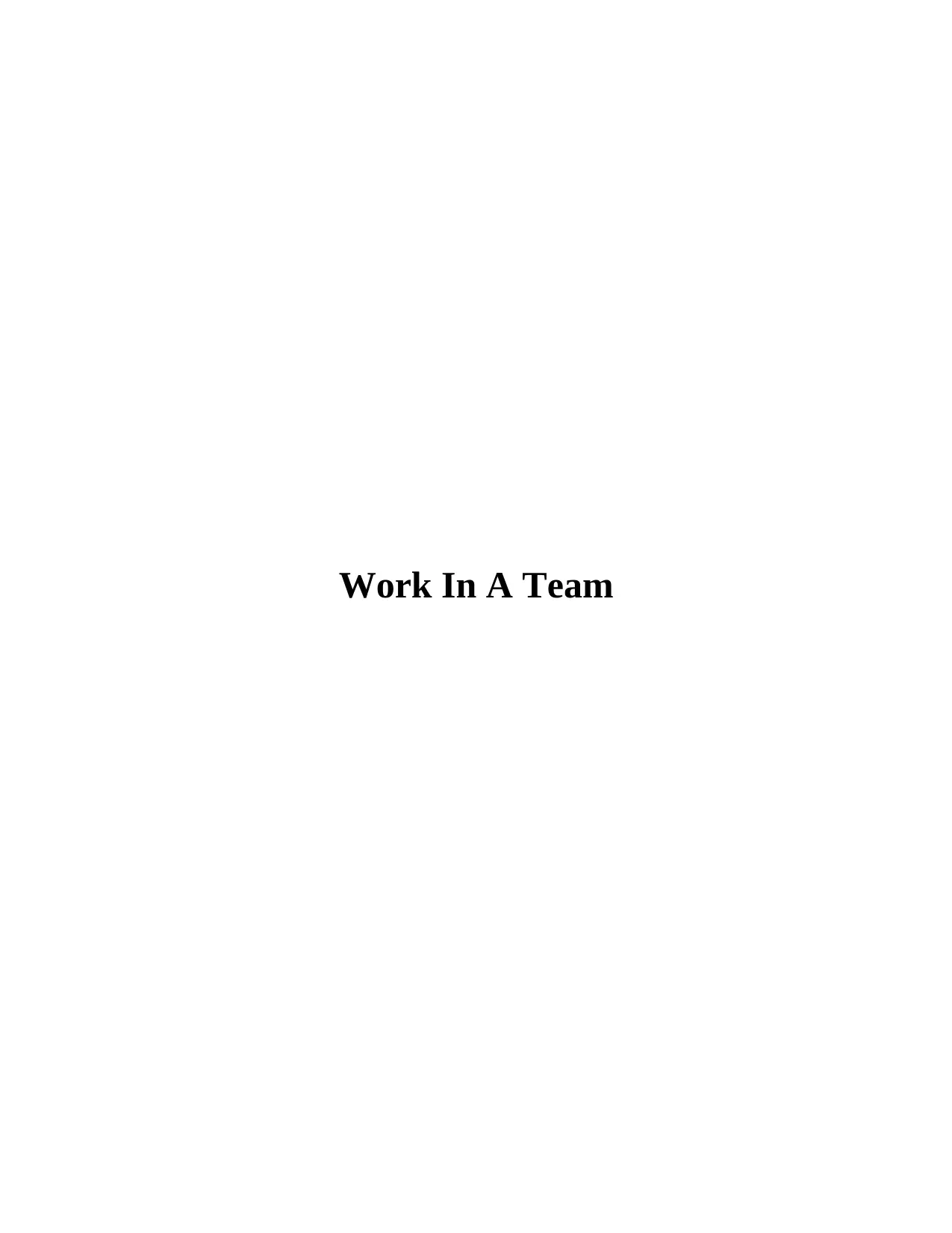
Work In A Team
Paraphrase This Document
Need a fresh take? Get an instant paraphrase of this document with our AI Paraphraser
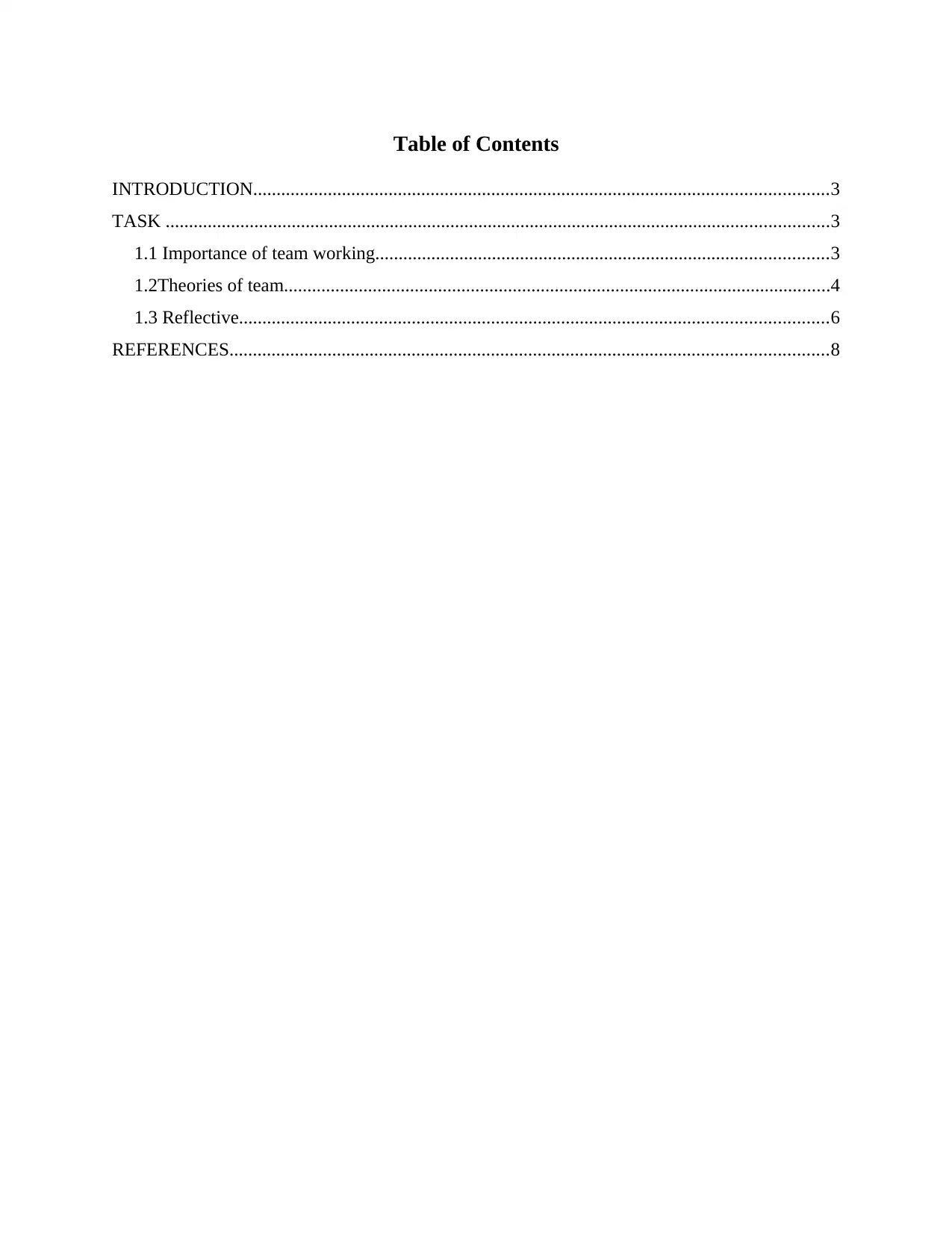
Table of Contents
INTRODUCTION...........................................................................................................................3
TASK ..............................................................................................................................................3
1.1 Importance of team working.................................................................................................3
1.2Theories of team.....................................................................................................................4
1.3 Reflective..............................................................................................................................6
REFERENCES................................................................................................................................8
INTRODUCTION...........................................................................................................................3
TASK ..............................................................................................................................................3
1.1 Importance of team working.................................................................................................3
1.2Theories of team.....................................................................................................................4
1.3 Reflective..............................................................................................................................6
REFERENCES................................................................................................................................8
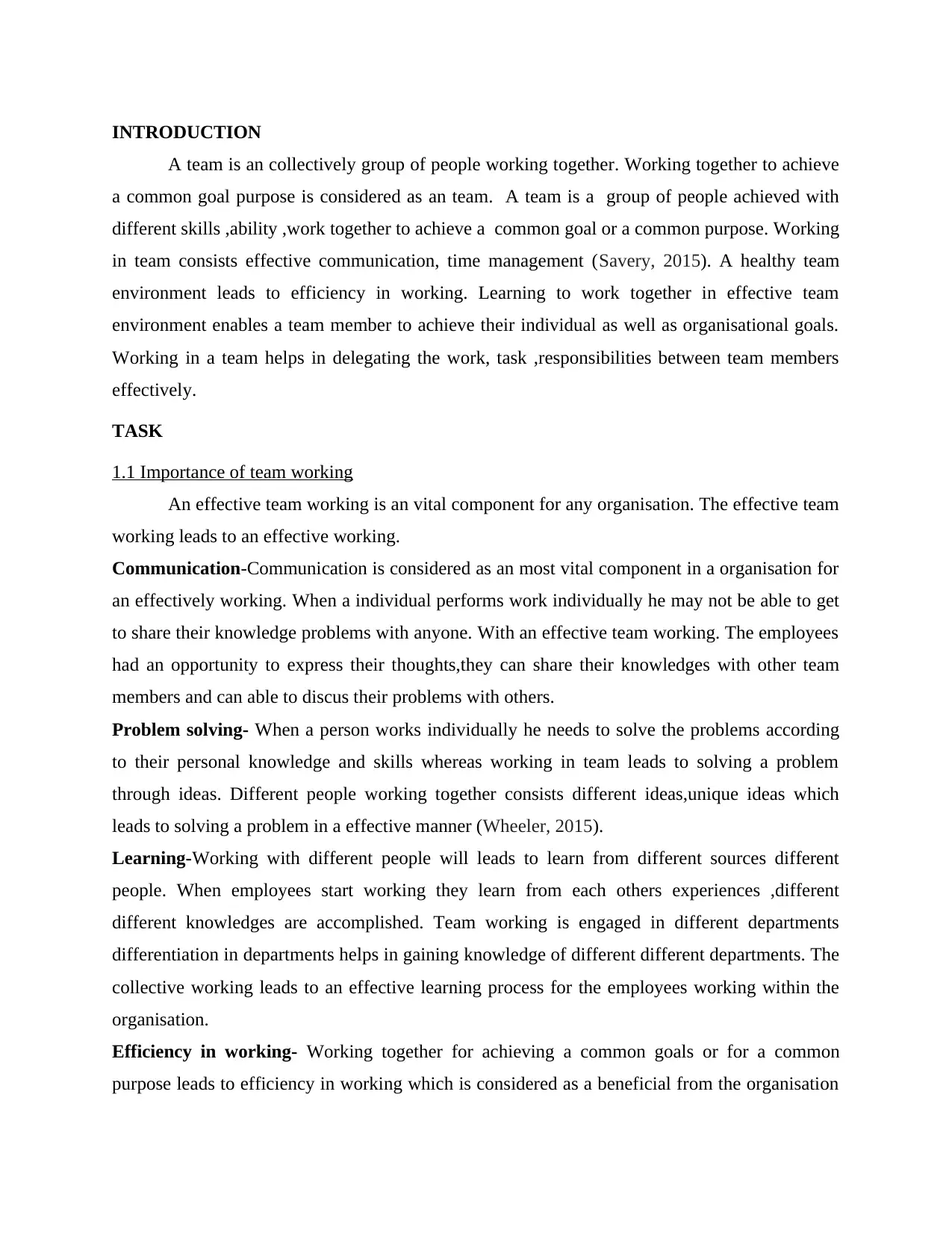
INTRODUCTION
A team is an collectively group of people working together. Working together to achieve
a common goal purpose is considered as an team. A team is a group of people achieved with
different skills ,ability ,work together to achieve a common goal or a common purpose. Working
in team consists effective communication, time management (Savery, 2015). A healthy team
environment leads to efficiency in working. Learning to work together in effective team
environment enables a team member to achieve their individual as well as organisational goals.
Working in a team helps in delegating the work, task ,responsibilities between team members
effectively.
TASK
1.1 Importance of team working
An effective team working is an vital component for any organisation. The effective team
working leads to an effective working.
Communication-Communication is considered as an most vital component in a organisation for
an effectively working. When a individual performs work individually he may not be able to get
to share their knowledge problems with anyone. With an effective team working. The employees
had an opportunity to express their thoughts,they can share their knowledges with other team
members and can able to discus their problems with others.
Problem solving- When a person works individually he needs to solve the problems according
to their personal knowledge and skills whereas working in team leads to solving a problem
through ideas. Different people working together consists different ideas,unique ideas which
leads to solving a problem in a effective manner (Wheeler, 2015).
Learning-Working with different people will leads to learn from different sources different
people. When employees start working they learn from each others experiences ,different
different knowledges are accomplished. Team working is engaged in different departments
differentiation in departments helps in gaining knowledge of different different departments. The
collective working leads to an effective learning process for the employees working within the
organisation.
Efficiency in working- Working together for achieving a common goals or for a common
purpose leads to efficiency in working which is considered as a beneficial from the organisation
A team is an collectively group of people working together. Working together to achieve
a common goal purpose is considered as an team. A team is a group of people achieved with
different skills ,ability ,work together to achieve a common goal or a common purpose. Working
in team consists effective communication, time management (Savery, 2015). A healthy team
environment leads to efficiency in working. Learning to work together in effective team
environment enables a team member to achieve their individual as well as organisational goals.
Working in a team helps in delegating the work, task ,responsibilities between team members
effectively.
TASK
1.1 Importance of team working
An effective team working is an vital component for any organisation. The effective team
working leads to an effective working.
Communication-Communication is considered as an most vital component in a organisation for
an effectively working. When a individual performs work individually he may not be able to get
to share their knowledge problems with anyone. With an effective team working. The employees
had an opportunity to express their thoughts,they can share their knowledges with other team
members and can able to discus their problems with others.
Problem solving- When a person works individually he needs to solve the problems according
to their personal knowledge and skills whereas working in team leads to solving a problem
through ideas. Different people working together consists different ideas,unique ideas which
leads to solving a problem in a effective manner (Wheeler, 2015).
Learning-Working with different people will leads to learn from different sources different
people. When employees start working they learn from each others experiences ,different
different knowledges are accomplished. Team working is engaged in different departments
differentiation in departments helps in gaining knowledge of different different departments. The
collective working leads to an effective learning process for the employees working within the
organisation.
Efficiency in working- Working together for achieving a common goals or for a common
purpose leads to efficiency in working which is considered as a beneficial from the organisation
⊘ This is a preview!⊘
Do you want full access?
Subscribe today to unlock all pages.

Trusted by 1+ million students worldwide
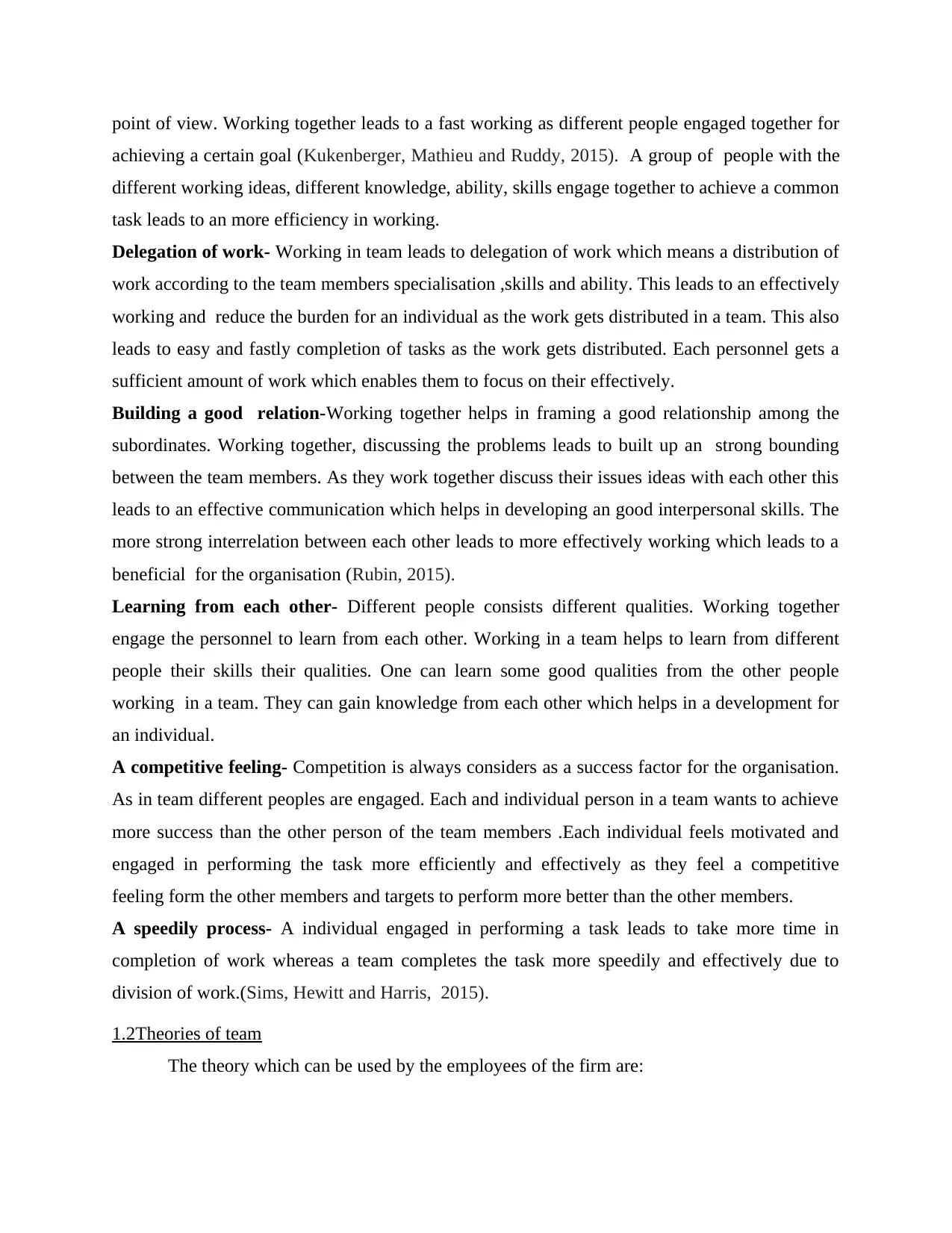
point of view. Working together leads to a fast working as different people engaged together for
achieving a certain goal (Kukenberger, Mathieu and Ruddy, 2015). A group of people with the
different working ideas, different knowledge, ability, skills engage together to achieve a common
task leads to an more efficiency in working.
Delegation of work- Working in team leads to delegation of work which means a distribution of
work according to the team members specialisation ,skills and ability. This leads to an effectively
working and reduce the burden for an individual as the work gets distributed in a team. This also
leads to easy and fastly completion of tasks as the work gets distributed. Each personnel gets a
sufficient amount of work which enables them to focus on their effectively.
Building a good relation-Working together helps in framing a good relationship among the
subordinates. Working together, discussing the problems leads to built up an strong bounding
between the team members. As they work together discuss their issues ideas with each other this
leads to an effective communication which helps in developing an good interpersonal skills. The
more strong interrelation between each other leads to more effectively working which leads to a
beneficial for the organisation (Rubin, 2015).
Learning from each other- Different people consists different qualities. Working together
engage the personnel to learn from each other. Working in a team helps to learn from different
people their skills their qualities. One can learn some good qualities from the other people
working in a team. They can gain knowledge from each other which helps in a development for
an individual.
A competitive feeling- Competition is always considers as a success factor for the organisation.
As in team different peoples are engaged. Each and individual person in a team wants to achieve
more success than the other person of the team members .Each individual feels motivated and
engaged in performing the task more efficiently and effectively as they feel a competitive
feeling form the other members and targets to perform more better than the other members.
A speedily process- A individual engaged in performing a task leads to take more time in
completion of work whereas a team completes the task more speedily and effectively due to
division of work.(Sims, Hewitt and Harris, 2015).
1.2Theories of team
The theory which can be used by the employees of the firm are:
achieving a certain goal (Kukenberger, Mathieu and Ruddy, 2015). A group of people with the
different working ideas, different knowledge, ability, skills engage together to achieve a common
task leads to an more efficiency in working.
Delegation of work- Working in team leads to delegation of work which means a distribution of
work according to the team members specialisation ,skills and ability. This leads to an effectively
working and reduce the burden for an individual as the work gets distributed in a team. This also
leads to easy and fastly completion of tasks as the work gets distributed. Each personnel gets a
sufficient amount of work which enables them to focus on their effectively.
Building a good relation-Working together helps in framing a good relationship among the
subordinates. Working together, discussing the problems leads to built up an strong bounding
between the team members. As they work together discuss their issues ideas with each other this
leads to an effective communication which helps in developing an good interpersonal skills. The
more strong interrelation between each other leads to more effectively working which leads to a
beneficial for the organisation (Rubin, 2015).
Learning from each other- Different people consists different qualities. Working together
engage the personnel to learn from each other. Working in a team helps to learn from different
people their skills their qualities. One can learn some good qualities from the other people
working in a team. They can gain knowledge from each other which helps in a development for
an individual.
A competitive feeling- Competition is always considers as a success factor for the organisation.
As in team different peoples are engaged. Each and individual person in a team wants to achieve
more success than the other person of the team members .Each individual feels motivated and
engaged in performing the task more efficiently and effectively as they feel a competitive
feeling form the other members and targets to perform more better than the other members.
A speedily process- A individual engaged in performing a task leads to take more time in
completion of work whereas a team completes the task more speedily and effectively due to
division of work.(Sims, Hewitt and Harris, 2015).
1.2Theories of team
The theory which can be used by the employees of the firm are:
Paraphrase This Document
Need a fresh take? Get an instant paraphrase of this document with our AI Paraphraser
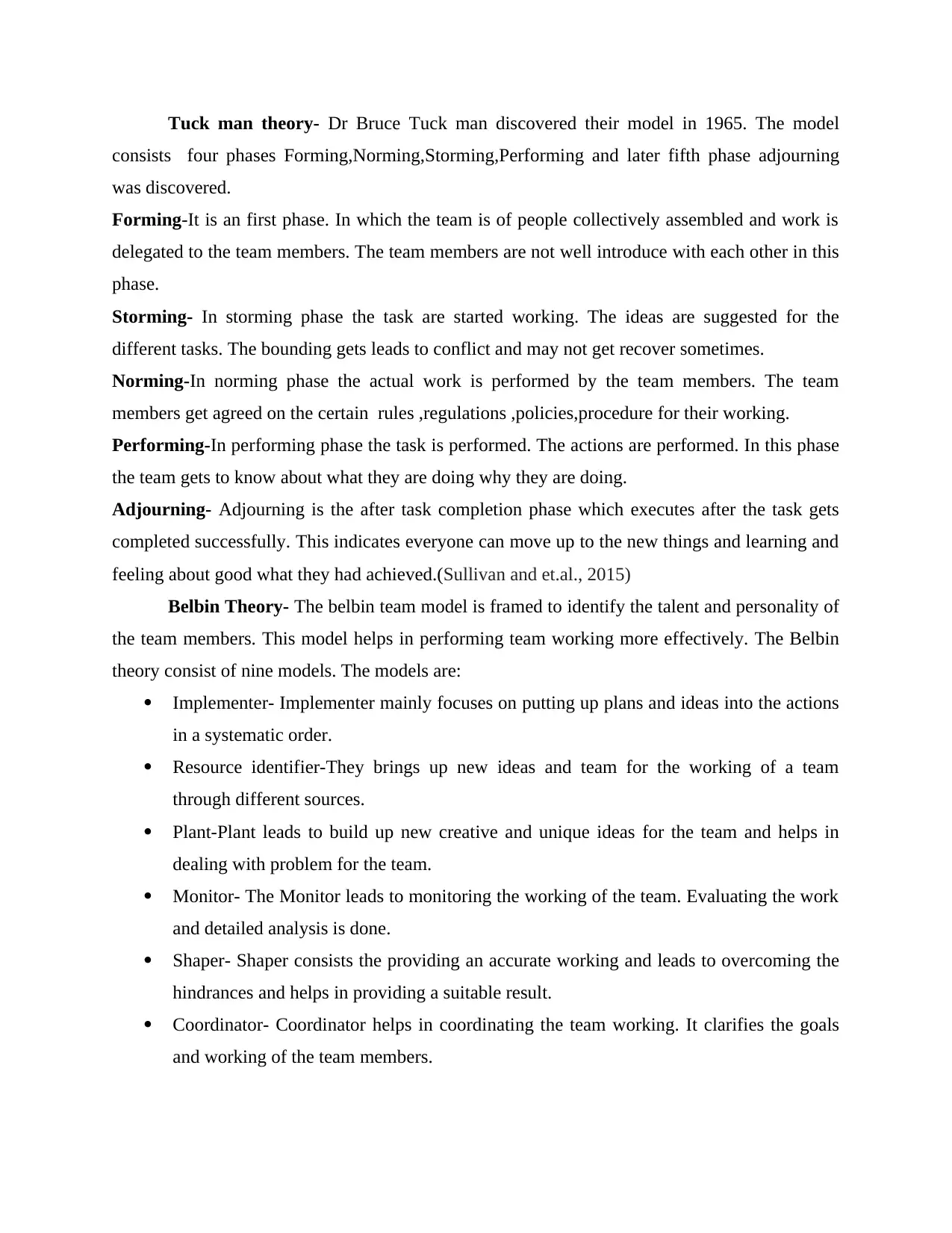
Tuck man theory- Dr Bruce Tuck man discovered their model in 1965. The model
consists four phases Forming,Norming,Storming,Performing and later fifth phase adjourning
was discovered.
Forming-It is an first phase. In which the team is of people collectively assembled and work is
delegated to the team members. The team members are not well introduce with each other in this
phase.
Storming- In storming phase the task are started working. The ideas are suggested for the
different tasks. The bounding gets leads to conflict and may not get recover sometimes.
Norming-In norming phase the actual work is performed by the team members. The team
members get agreed on the certain rules ,regulations ,policies,procedure for their working.
Performing-In performing phase the task is performed. The actions are performed. In this phase
the team gets to know about what they are doing why they are doing.
Adjourning- Adjourning is the after task completion phase which executes after the task gets
completed successfully. This indicates everyone can move up to the new things and learning and
feeling about good what they had achieved.(Sullivan and et.al., 2015)
Belbin Theory- The belbin team model is framed to identify the talent and personality of
the team members. This model helps in performing team working more effectively. The Belbin
theory consist of nine models. The models are:
Implementer- Implementer mainly focuses on putting up plans and ideas into the actions
in a systematic order.
Resource identifier-They brings up new ideas and team for the working of a team
through different sources.
Plant-Plant leads to build up new creative and unique ideas for the team and helps in
dealing with problem for the team.
Monitor- The Monitor leads to monitoring the working of the team. Evaluating the work
and detailed analysis is done.
Shaper- Shaper consists the providing an accurate working and leads to overcoming the
hindrances and helps in providing a suitable result.
Coordinator- Coordinator helps in coordinating the team working. It clarifies the goals
and working of the team members.
consists four phases Forming,Norming,Storming,Performing and later fifth phase adjourning
was discovered.
Forming-It is an first phase. In which the team is of people collectively assembled and work is
delegated to the team members. The team members are not well introduce with each other in this
phase.
Storming- In storming phase the task are started working. The ideas are suggested for the
different tasks. The bounding gets leads to conflict and may not get recover sometimes.
Norming-In norming phase the actual work is performed by the team members. The team
members get agreed on the certain rules ,regulations ,policies,procedure for their working.
Performing-In performing phase the task is performed. The actions are performed. In this phase
the team gets to know about what they are doing why they are doing.
Adjourning- Adjourning is the after task completion phase which executes after the task gets
completed successfully. This indicates everyone can move up to the new things and learning and
feeling about good what they had achieved.(Sullivan and et.al., 2015)
Belbin Theory- The belbin team model is framed to identify the talent and personality of
the team members. This model helps in performing team working more effectively. The Belbin
theory consist of nine models. The models are:
Implementer- Implementer mainly focuses on putting up plans and ideas into the actions
in a systematic order.
Resource identifier-They brings up new ideas and team for the working of a team
through different sources.
Plant-Plant leads to build up new creative and unique ideas for the team and helps in
dealing with problem for the team.
Monitor- The Monitor leads to monitoring the working of the team. Evaluating the work
and detailed analysis is done.
Shaper- Shaper consists the providing an accurate working and leads to overcoming the
hindrances and helps in providing a suitable result.
Coordinator- Coordinator helps in coordinating the team working. It clarifies the goals
and working of the team members.
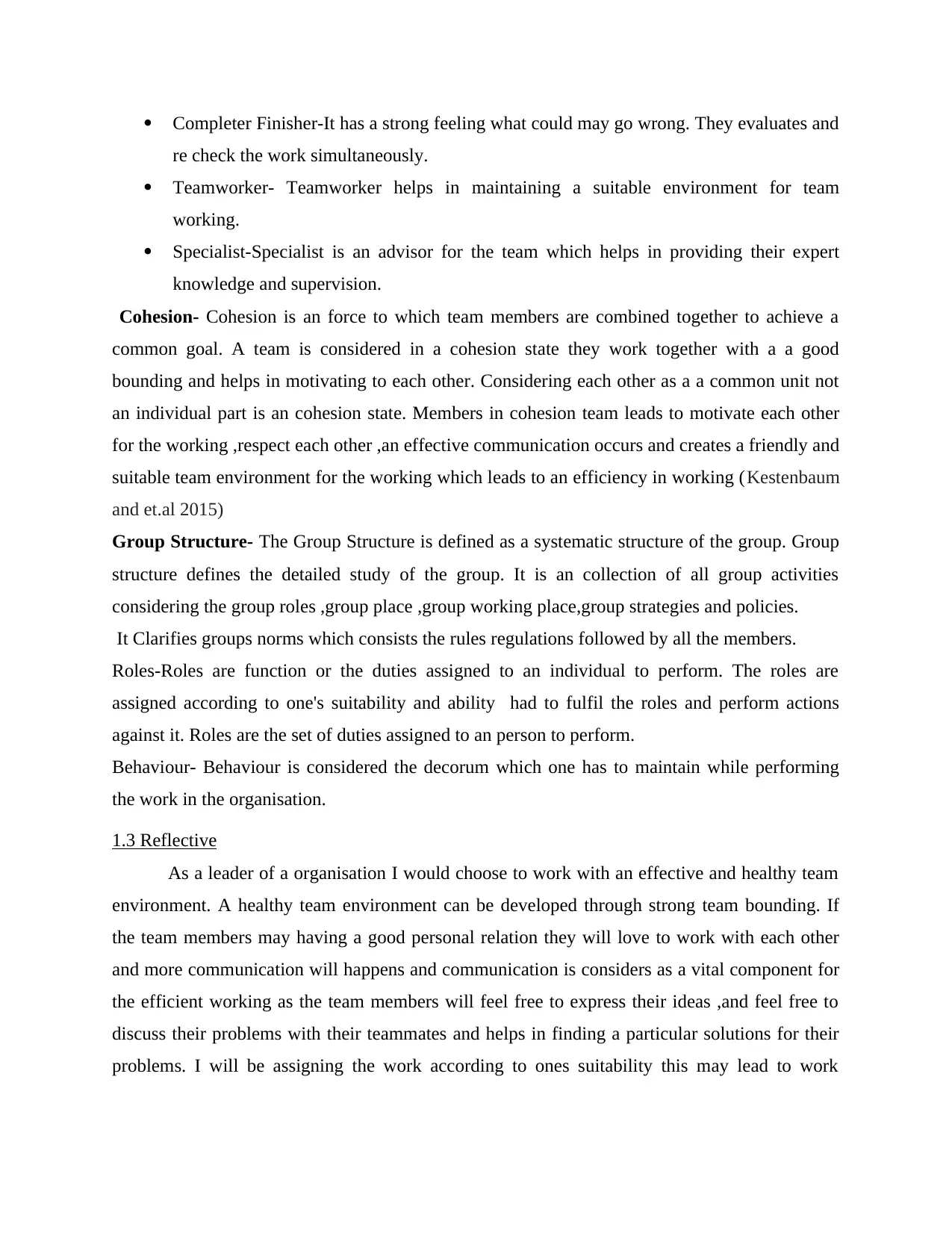
Completer Finisher-It has a strong feeling what could may go wrong. They evaluates and
re check the work simultaneously.
Teamworker- Teamworker helps in maintaining a suitable environment for team
working.
Specialist-Specialist is an advisor for the team which helps in providing their expert
knowledge and supervision.
Cohesion- Cohesion is an force to which team members are combined together to achieve a
common goal. A team is considered in a cohesion state they work together with a a good
bounding and helps in motivating to each other. Considering each other as a a common unit not
an individual part is an cohesion state. Members in cohesion team leads to motivate each other
for the working ,respect each other ,an effective communication occurs and creates a friendly and
suitable team environment for the working which leads to an efficiency in working (Kestenbaum
and et.al 2015)
Group Structure- The Group Structure is defined as a systematic structure of the group. Group
structure defines the detailed study of the group. It is an collection of all group activities
considering the group roles ,group place ,group working place,group strategies and policies.
It Clarifies groups norms which consists the rules regulations followed by all the members.
Roles-Roles are function or the duties assigned to an individual to perform. The roles are
assigned according to one's suitability and ability had to fulfil the roles and perform actions
against it. Roles are the set of duties assigned to an person to perform.
Behaviour- Behaviour is considered the decorum which one has to maintain while performing
the work in the organisation.
1.3 Reflective
As a leader of a organisation I would choose to work with an effective and healthy team
environment. A healthy team environment can be developed through strong team bounding. If
the team members may having a good personal relation they will love to work with each other
and more communication will happens and communication is considers as a vital component for
the efficient working as the team members will feel free to express their ideas ,and feel free to
discuss their problems with their teammates and helps in finding a particular solutions for their
problems. I will be assigning the work according to ones suitability this may lead to work
re check the work simultaneously.
Teamworker- Teamworker helps in maintaining a suitable environment for team
working.
Specialist-Specialist is an advisor for the team which helps in providing their expert
knowledge and supervision.
Cohesion- Cohesion is an force to which team members are combined together to achieve a
common goal. A team is considered in a cohesion state they work together with a a good
bounding and helps in motivating to each other. Considering each other as a a common unit not
an individual part is an cohesion state. Members in cohesion team leads to motivate each other
for the working ,respect each other ,an effective communication occurs and creates a friendly and
suitable team environment for the working which leads to an efficiency in working (Kestenbaum
and et.al 2015)
Group Structure- The Group Structure is defined as a systematic structure of the group. Group
structure defines the detailed study of the group. It is an collection of all group activities
considering the group roles ,group place ,group working place,group strategies and policies.
It Clarifies groups norms which consists the rules regulations followed by all the members.
Roles-Roles are function or the duties assigned to an individual to perform. The roles are
assigned according to one's suitability and ability had to fulfil the roles and perform actions
against it. Roles are the set of duties assigned to an person to perform.
Behaviour- Behaviour is considered the decorum which one has to maintain while performing
the work in the organisation.
1.3 Reflective
As a leader of a organisation I would choose to work with an effective and healthy team
environment. A healthy team environment can be developed through strong team bounding. If
the team members may having a good personal relation they will love to work with each other
and more communication will happens and communication is considers as a vital component for
the efficient working as the team members will feel free to express their ideas ,and feel free to
discuss their problems with their teammates and helps in finding a particular solutions for their
problems. I will be assigning the work according to ones suitability this may lead to work
⊘ This is a preview!⊘
Do you want full access?
Subscribe today to unlock all pages.

Trusted by 1+ million students worldwide
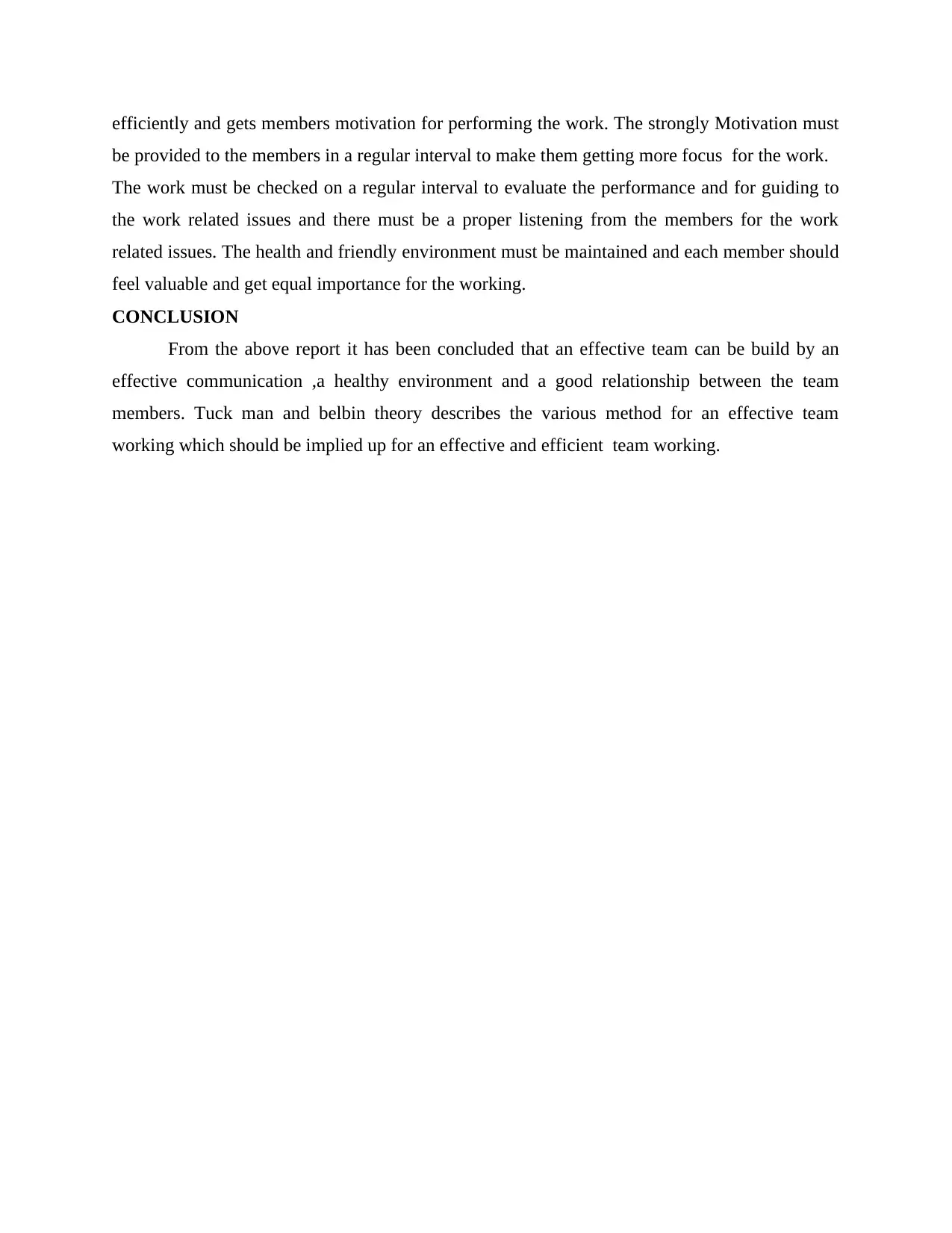
efficiently and gets members motivation for performing the work. The strongly Motivation must
be provided to the members in a regular interval to make them getting more focus for the work.
The work must be checked on a regular interval to evaluate the performance and for guiding to
the work related issues and there must be a proper listening from the members for the work
related issues. The health and friendly environment must be maintained and each member should
feel valuable and get equal importance for the working.
CONCLUSION
From the above report it has been concluded that an effective team can be build by an
effective communication ,a healthy environment and a good relationship between the team
members. Tuck man and belbin theory describes the various method for an effective team
working which should be implied up for an effective and efficient team working.
be provided to the members in a regular interval to make them getting more focus for the work.
The work must be checked on a regular interval to evaluate the performance and for guiding to
the work related issues and there must be a proper listening from the members for the work
related issues. The health and friendly environment must be maintained and each member should
feel valuable and get equal importance for the working.
CONCLUSION
From the above report it has been concluded that an effective team can be build by an
effective communication ,a healthy environment and a good relationship between the team
members. Tuck man and belbin theory describes the various method for an effective team
working which should be implied up for an effective and efficient team working.
Paraphrase This Document
Need a fresh take? Get an instant paraphrase of this document with our AI Paraphraser
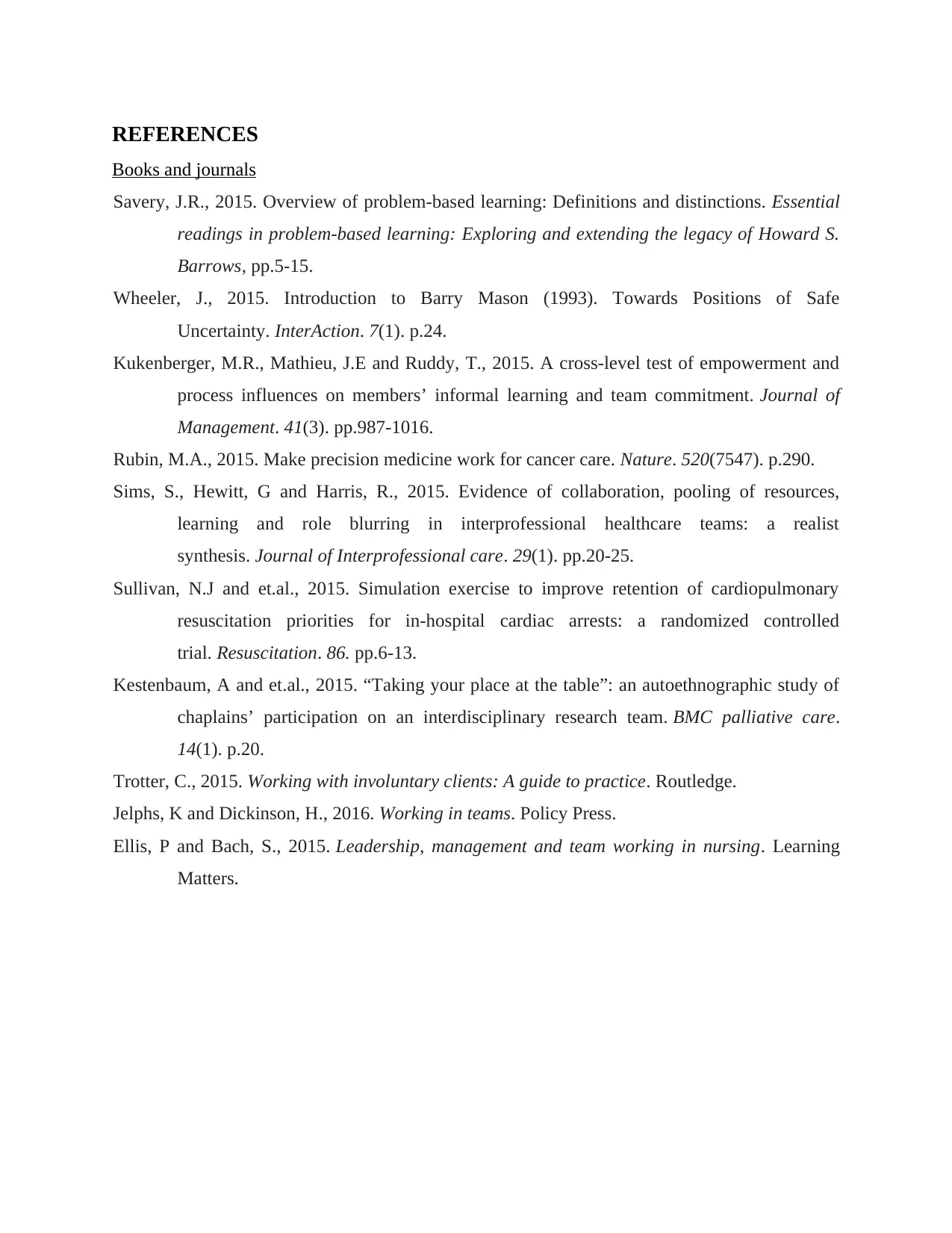
REFERENCES
Books and journals
Savery, J.R., 2015. Overview of problem-based learning: Definitions and distinctions. Essential
readings in problem-based learning: Exploring and extending the legacy of Howard S.
Barrows, pp.5-15.
Wheeler, J., 2015. Introduction to Barry Mason (1993). Towards Positions of Safe
Uncertainty. InterAction. 7(1). p.24.
Kukenberger, M.R., Mathieu, J.E and Ruddy, T., 2015. A cross-level test of empowerment and
process influences on members’ informal learning and team commitment. Journal of
Management. 41(3). pp.987-1016.
Rubin, M.A., 2015. Make precision medicine work for cancer care. Nature. 520(7547). p.290.
Sims, S., Hewitt, G and Harris, R., 2015. Evidence of collaboration, pooling of resources,
learning and role blurring in interprofessional healthcare teams: a realist
synthesis. Journal of Interprofessional care. 29(1). pp.20-25.
Sullivan, N.J and et.al., 2015. Simulation exercise to improve retention of cardiopulmonary
resuscitation priorities for in-hospital cardiac arrests: a randomized controlled
trial. Resuscitation. 86. pp.6-13.
Kestenbaum, A and et.al., 2015. “Taking your place at the table”: an autoethnographic study of
chaplains’ participation on an interdisciplinary research team. BMC palliative care.
14(1). p.20.
Trotter, C., 2015. Working with involuntary clients: A guide to practice. Routledge.
Jelphs, K and Dickinson, H., 2016. Working in teams. Policy Press.
Ellis, P and Bach, S., 2015. Leadership, management and team working in nursing. Learning
Matters.
Books and journals
Savery, J.R., 2015. Overview of problem-based learning: Definitions and distinctions. Essential
readings in problem-based learning: Exploring and extending the legacy of Howard S.
Barrows, pp.5-15.
Wheeler, J., 2015. Introduction to Barry Mason (1993). Towards Positions of Safe
Uncertainty. InterAction. 7(1). p.24.
Kukenberger, M.R., Mathieu, J.E and Ruddy, T., 2015. A cross-level test of empowerment and
process influences on members’ informal learning and team commitment. Journal of
Management. 41(3). pp.987-1016.
Rubin, M.A., 2015. Make precision medicine work for cancer care. Nature. 520(7547). p.290.
Sims, S., Hewitt, G and Harris, R., 2015. Evidence of collaboration, pooling of resources,
learning and role blurring in interprofessional healthcare teams: a realist
synthesis. Journal of Interprofessional care. 29(1). pp.20-25.
Sullivan, N.J and et.al., 2015. Simulation exercise to improve retention of cardiopulmonary
resuscitation priorities for in-hospital cardiac arrests: a randomized controlled
trial. Resuscitation. 86. pp.6-13.
Kestenbaum, A and et.al., 2015. “Taking your place at the table”: an autoethnographic study of
chaplains’ participation on an interdisciplinary research team. BMC palliative care.
14(1). p.20.
Trotter, C., 2015. Working with involuntary clients: A guide to practice. Routledge.
Jelphs, K and Dickinson, H., 2016. Working in teams. Policy Press.
Ellis, P and Bach, S., 2015. Leadership, management and team working in nursing. Learning
Matters.
1 out of 8
Related Documents
Your All-in-One AI-Powered Toolkit for Academic Success.
+13062052269
info@desklib.com
Available 24*7 on WhatsApp / Email
![[object Object]](/_next/static/media/star-bottom.7253800d.svg)
Unlock your academic potential
Copyright © 2020–2025 A2Z Services. All Rights Reserved. Developed and managed by ZUCOL.





